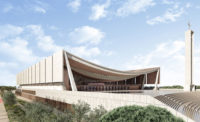After last year’s devastating hurricane season, architecture schools are incorporating resilient design into their curriculums, acknowledging that climate change will increasingly effect how cities are built, and emphasizing the role the next generation of architects will undoubtedly play in preparing and responding to future disasters.
At the University of Houston’s architecture and design school, one studio this spring focused their semester on how to design buildings at various scales that will play a role in each phase of a natural disaster. As part of their classwork, students visited sites throughout the city that were most affected by Hurricane Harvey. They also gathered data and met with local leaders involved in the response to last year’s Category 4 hurricane. An exhibit showcasing the solutions the class proposed for preparing and reacting to each phase of a disaster like Harvey—from a storm shelter to information centers—will be on display at the school on April 24.
Meanwhile, architecture students from The Cooper Union and the University of Puerto Rico also teamed up to examine areas within the city of San Juan that were badly damaged by Hurricane Maria as part of a semester-long project to create resilient housing in contexts similar to Puerto Rico with tropical climates. The result of the third-year studio held throughout this semester at Cooper, taught by Professors Lorena del Río, Kevin Bone, and Mersiha Veledar, is on display at the New York City-based school through April 27 with students’ proposals featuring the use of solar power and local resources among other ideas.
Though architects around the country endeavor to respond to the major damage from Hurricanes Harvey, Irma and Maria, the conversation about what resilient design can or should look like remains at its naissance. But now there is a new awareness of the importance of considering how the built-environment might fare in disasters that previously seemed unthinkable.








Post a comment to this article
Report Abusive Comment